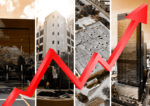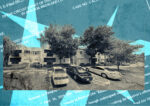Miami-Dade County became a magnet for new-to-market firms from late 2020 to early last year. As companies gobbled up office space, real estate circles were especially giddy over two industries: financial services and tech.
Once billionaire Ken Griffin moved his Citadel and Citadel Securities’ headquarters to Miami, the city’s fate as a mecca for financial firms seemed sealed. And the tech firm influx to the city led some to rechristen Miami as “Silicon Valley of the South.”
Yet, financial and tech firms are now the top contributors to the sublease availability in Miami-Dade, according to a new CBRE report.
Financial services companies have 128,000 square feet of office space up for sublease, and tech and telecommunications firms have 112,000 square feet, according to Ilyssa Ettelman, who worked on the report. This accounts for about 37 and 34 percent of the share, respectively, of the county’s 397,000 square feet of available subleasing space, according to CBRE’s data.
Inflationary pressures and high borrowing costs are impacting these companies’ national and international business, prompting them to cut expenses where they can, including shaving off their Miami-Dade office footprint, according to brokers.
Read more



“Financial services and tech are generally international corporations. So if you are going bad everywhere except South Florida, but you are cutting back as an organization on a macro basis, South Florida is going to be impacted,” Robert Orban of Cresa said. “Who has a tech business that only serves Miami and South Florida? Nobody.”
In the rest of South Florida, financial services firms aren’t top contributors to the sublease availability. But tech and telecommunications firms accounted for the second largest share of sublease availability in Broward County and Palm Beach County. In Broward, these tenants have 139,000 square feet on the market, or 20.8 percent of the county’s 752,000 square feet of space for sublease, according to CBRE. In Palm Beach, tech firms have 104,000 square feet of space on the market, or just below 19 percent of the county’s 687,000 square feet for sublease.
The remote-work shift is somewhat to blame. While South Florida universities have worked to meet tech workers’ needs, the region still isn’t producing enough skilled talent, said Grant Killingsworth, a broker at CBRE. Firms are turning to hiring out-of-state, meaning many of these employees aren’t working in Miami offices.
“Also a lot of homegrown talent that is leaving to go to universities outside of South Florida is not coming back,” he said. It “has been an ongoing issue of kind of the brain drain of talent here in South Florida.”
The big picture
Overall, South Florida’s office sublease availability of 1.8 million square feet marks a nearly 15-percent increase year-over-year, CBRE’s data shows.
While this dents the storyline of South Florida’s office real estate being immune to woes plaguing other U.S. markets, experts said the growth is a normal outcome of the economic headwinds and slowed influx of businesses.
In “2021 and 2022, it was an avalanche of companies moving to South Florida. I don’t want to say it’s dried up, [but] that number has diminished,” Killingsworth said. “There’s not a sense of urgency for these organizations to move here as there has been in the past.”
While Miami-Dade experienced a drop in sublease availability by 107,000 square feet in the past year, Broward saw it increase by 85,000 square feet, a comparison between CBRE’s report from September last year and this year shows. Palm Beach experienced the biggest sublease availability growth, adding 254,000 square feet on the market.
The three submarkets of Boca Raton North, Boca Raton West and Boca Raton East accounted for the largest share, or 78 percent of the county sublease availability, according to the report.
That’s consistent with CBRE’s finding that suburban areas, as opposed to central business districts, accounted for a larger share, or 67 percent of the tri-county region’s sublease availability.
CBRE also found that the majority of space on the market is Class A.
While this counters a long-held narrative that top office spaces with high-end finishes and coveted amenities will remain in demand, Orban said it also isn’t a surprise. The companies that were in expansion mode in recent years homed in on Class A buildings.
“If you are a financial services firm or a national or international tech firm, you are generally leasing this kind of space as opposed to Class B space,” he said. “When you are having to cut back that’s where it goes.”
South Florida still is outperforming the rest of the nation, Ettelman said. The region’s sublease availability is 2.6 percent of the total office inventory, while nationwide the sublease availability is nearing 5 percent of the inventory, she said.
Traditionally, 30 percent of the space on the market is subleased and 20 percent expires, meaning the lease term runs out, before a sub-tenant is found, she said.
And not all space put back on the market stays there. Roughly 38 percent of the square footage that is for sublease is taken off the market as tenants decide to keep their full footprint.
“Early on in the pandemic” for example, she said, “there were a number of tenants who listed space but then went back into the space.”
Brickell bonanza? Hardly
Much of the hype with Miami’s office market is over Brickell, which is home to a canyon of skyscrapers that make up the city’s financial district.
But the neighborhood has 95,000 square feet of offices on the market, accounting for 24 percent –– or the biggest share –– of Miami-Dade’s sublease availability, according to CBRE.
The leasing frenzy of the past three years largely focused on Brickell, with firms rushing to lock down spaces in the neighborhood before they had concrete ideas about the number of employees they would need in Miami or the necessary size of their office footprints.
“I think what we are seeing is some of the after-effects of how their plans worked out,” said Killingsworth, who declined to identify firms that are seeking to sublease Brickell space.
But sources told The Real Deal that law firm Akerman wants to offload one floor spanning 17,000 square feet from its office at 98 Southeast Seventh Street at Brickell City Centre. Akerman didn’t return a request for comment.
This summer, law firm Kirkland & Ellis put two floors spanning 27,500 square feet at 830 Brickell on the market. The firm had signed the biggest new-to-market lease in late 2021 at 115,000 square feet on six levels at the building. Sources told TRD that the firm wanted to lock down the space for future growth but doesn’t immediately need all of it.
Brickell’s high asking rents, which reached well-over $100 per square foot at some buildings, could be a boon for tenants that sublease space. But the sticker shock also is turning off others from the area.
Orban said the landlord of a 6,000-square-foot, 20th-story space at 701 Brickell has been trying to lease the office ever since the previous tenant’s term ran out two years ago.
“They are asking a lot of money,” he said, adding that the asking rent is about $85 per square foot. “The demand isn’t as strong as in ‘21 and ‘22.”




